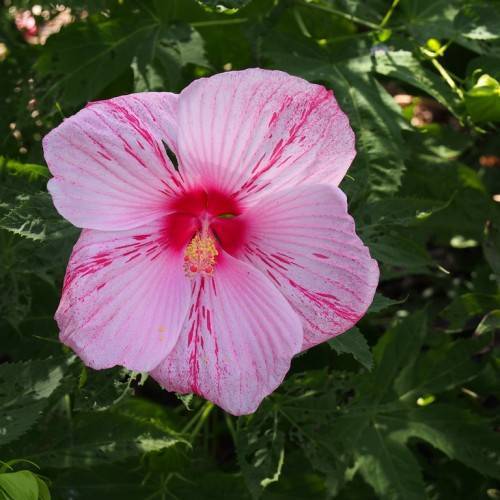
hardy hibiscus
Hibiscus moscheutos (incl. hybrid cvs.)
Also Known As - swamp rose mallowCycle:
Herbaceous Perennial
Watering:
Frequent
Hardiness Zone:
4
Flowers:
Flowers In Spring
Sun:
Filtered shade, Full sun, Part sun/part shade
Soil:
Well-drained
Fruits:
Fruits In Summer Ready In Fall
Leaf:
Yes
Growth Rate:
High
Drought Tolerant:
Yes
watering
Water your fancy-leafed coral bells (Heuchera micrantha cvs.) deeply once a week in the spring and summer, unless rain is frequent. Water as deeply as possible to moisten the entire root ball, ensuring that the water reaches all of the plant's roots. In the fall and winter, water only when the soil begins to feel dry. Avoid letting the soil dry out completely, but don't keep it too moist either. To help conserve water, apply a layer of mulch over the soil in the growing season.
sunlight
Fancy-leafed coral bells (Heuchera micrantha cvs.) prefer full sun to partial shade. While they will tolerate full shade, they need at least 4-6 hours of direct sunlight each day to reach their full potential. If kept consistently in partial shade or full shade for more than a few weeks, coral bells may not flower or produce the bold fall foliage associated with this plant species.
pruning
For Fancy-Leafed Coral Bells (Heuchera micrantha cvs.), it is best to prune during late winter or early spring, before the new growth appears. Pruning should be done to rejuvenate the plant and remove any dead or unsightly foliage. Remove all winter-damaged or discolored foliage down to the crown of the plant. Avoid pruning too dramatically, as it can reduce the density and health of the foliage. It also removes the potential for new flowers to form. Deadheading of flowers after they bloom is also good to practice in order to keep the plant tidy. To maximize flowering, be sure to give the plant adequate sunlight and water.
